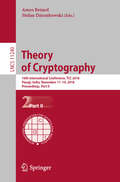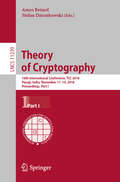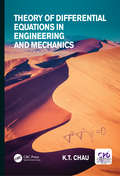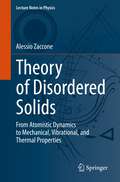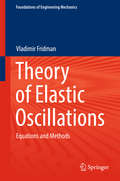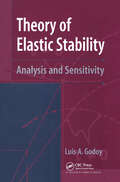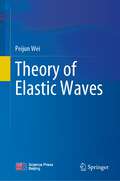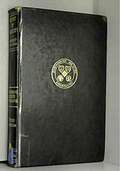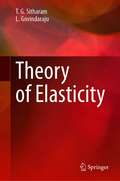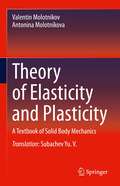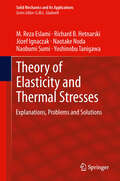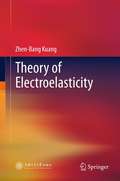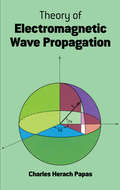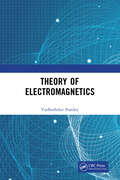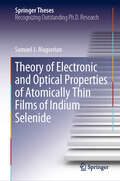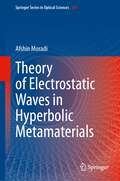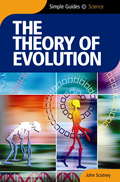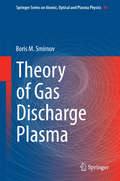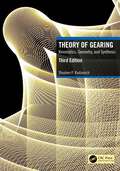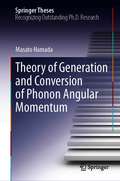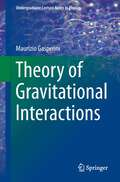- Table View
- List View
Theory of Cryptography: 16th International Conference, TCC 2018, Panaji, India, November 11–14, 2018, Proceedings, Part II (Lecture Notes in Computer Science #11240)
by Amos Beimel Stefan DziembowskiThe two-volume set of LNCS 11239 and LNCS 11240 constitutes the revised proceedings of the 16th International Conference on Theory of Cryptography, TCC 2018, held in Panaji, India, in November 2018.The total of 50 revised full papers presented in the proceedings were carefully reviewed and selected from 168 submissions. The Theory of Cryptography Conference deals with the paradigms, approaches, and techniques used to conceptualize natural cryptographic problems and provide algorithmic solutions to them and much more.
Theory of Cryptography: 16th International Conference, Tcc 2018, Panaji, India, November 11-14, 2018, Proceedings, Part Ii (Lecture Notes in Computer Science #11240)
by Amos Beimel Stefan DziembowskiThe two-volume set of LNCS 11239 and LNCS 11240 constitutes the revised proceedings of the 16th International Conference on Theory of Cryptography, TCC 2018, held in Panaji, India, in November 2018.The total of 50 revised full papers presented in the proceedings were carefully reviewed and selected from 168 submissions. The Theory of Cryptography Conference deals with the paradigms, approaches, and techniques used to conceptualize natural cryptographic problems and provide algorithmic solutions to them and much more.
Theory of Decision under Uncertainty
by Itzhak GilboaThis book describes the classical axiomatic theories of decision under uncertainty, as well as critiques thereof and alternative theories. It focuses on the meaning of probability, discussing some definitions and surveying their scope of applicability. The behavioral definition of subjective probability serves as a way to present the classical theories, culminating in Savage's theorem. The limitations of this result as a definition of probability lead to two directions - first, similar behavioral definitions of more general theories, such as non-additive probabilities and multiple priors, and second, cognitive derivations based on case-based techniques.
Theory of Differential Equations in Engineering and Mechanics
by Kam Tim ChauThis gives comprehensive coverage of the essential differential equations students they are likely to encounter in solving engineering and mechanics problems across the field -- alongside a more advance volume on applications. This first volume covers a very broad range of theories related to solving differential equations, mathematical preliminaries, ODE (n-th order and system of 1st order ODE in matrix form), PDE (1st order, 2nd, and higher order including wave, diffusion, potential, biharmonic equations and more). Plus more advanced topics such as Green’s function method, integral and integro-differential equations, asymptotic expansion and perturbation, calculus of variations, variational and related methods, finite difference and numerical methods. All readers who are concerned with and interested in engineering mechanics problems, climate change, and nanotechnology will find topics covered in these books providing valuable information and mathematics background for their multi-disciplinary research and education.
Theory of Dislocations
by Peter Martin Anderson John Price Hirth Jens LotheA basic text on defects in materials, emphasizing the fundamentals of dislocations and their applications to understanding physical phenomena. The new edition discusses recent discoveries in dislocation theory and includes new material on displacement fields of dislocations, atomic calculations, advanced anisotropic elastic theory, equations for the stress fields of loops, and grain boundary dislocations. Includes extensive treatment of the mathematics of dislocations.
Theory of Disordered Solids: From Atomistic Dynamics to Mechanical, Vibrational, and Thermal Properties (Lecture Notes in Physics #1015)
by Alessio ZacconeThis book presents a consistent mathematical theory of the non-electronic physical properties of disordered and amorphous solids, starting from the atomic-level dynamics and leading to experimentally verifiable descriptions of macroscopic properties such as elastic and viscoelastic moduli, plasticity, phonons and vibrational spectra, and thermal properties. This theory begins with the assumption of the undeniable existence of an “amorphous lattice”, which allows one to relegate the theoretical uncertainties about the ultimate nature of the glass transition to a subsidiary role and thus take a more pragmatic approach towards the modelling of physical properties. The book introduces the reader not only to the subtle physical concepts underlying the dynamics, mechanics, and statistical physics of glasses and amorphous solids, but also to the essential mathematical and numerical methods that cannot be readily gleaned from specialized literature since they are spread out among many often technically demanding papers. These methods are presented in this book in such a way as to be sufficiently general, allowing for the mathematical or numerical description of novel physical phenomena observed in many different types of amorphous solids (including soft and granular systems), regardless of the atomistic details and particular chemistry of the material. This monograph is aimed at researchers and graduate-level students in physics, materials science, physical chemistry and engineering working in the areas of amorphous materials, soft matter and granular systems, statistical physics, continuum mechanics, plasticity, and solid mechanics. It is also particularly well suited to those working on molecular dynamics simulations, molecular coarse-grained simulations, as well as ab initio atomistic and DFT methods for solid-state and materials science.
Theory of Elastic Oscillations
by Vladimir FridmanThis book presents in detail an alternative approach to solving problems involving both linear and nonlinear oscillations of elastic distributed parameter systems. It includes the so-called variational, projection and iterative gradient methods, which, when applied to nonlinear problems, use the procedure of linearization of the original non-linear equations. These methods are not universal and require a different solution for each problem or class of problems. However, in many cases the combination of the methods shown in this book leads to more efficient algorithms for solving important applied problems. To record these algorithms in a unified form, the first part of the book and its appendix devote considerable attention to compiling the general operator equations, which include (as particular cases) equations for vibrations in rods, plates, shells and three-dimensional bodies. They are mainly considered to be periodic or nearly periodic oscillations, which correspond to stationary or nearly stationary regimes of machinery operation. In turn, the second part of the book presents a number of solutions for selected applications.
Theory of Elastic Stability: Analysis and Sensitivity
by Luis A. GodoyThis book gives a unified presentation of the field of stability. Buckling and post-buckling states are studied on the basis of total potential energy of structural systems. Emphasis is placed throughout the text on post-buckling analysis and behaviour. The sensitivity of buckling and post-buckling states to changes in design parameters is also discussed as well as changes due to imperfections and damage.
Theory of Elastic Waves
by Peijun WeiThis book highlights a systematic introduction to the basic theory of elastic wave propagation in complex media. The theory of elastic waves is widely used in fields such as geophysical exploration, seismic survey, medical ultrasound imaging, nondestructive testing of materials and structures, phononic crystals, metamaterials and structure health monitoring. To help readers develop a systematic grasp of the basic theory, and thus its applications, the book elaborates on the theory of elastic wave propagation in isotropic solid media, covering phenomena in infinite media, interfaces, layered structure with finite thickness, Rayleigh wave and Love wave propagating along the surface of semi-infinite solid and covering layer, and the guided waves and leaky waves in flat plates and in cylindrical rods. The propagation patterns and features of guided waves in cylindrical shells and spherical shells are also introduced. The author wrote the book based on a decade of teaching experience of a graduate course of the same name and two decades of research on the theory and applications. The book is a valuable reference for students, researchers and professionals who expect an understandable and comprehensive discussion of the theory, analytical methods and related research results.
Theory of Elasticity
by Stephen P. Timoshenko J. N. GoodierIn the revision of this book for a third edition, the primary intention and plan of the first edition have been preserved--to provide for engineers, in as simple a form as the subject allows, the essential fundamental knowledge of the theory of elasticity together with a compilation of solutions of special problems that are important in engineering practice and design. The numerous footnote references indicate how the several topics may be pursued further. Since these are now readily supplemented by means of Applied Mechanics Reviews, new footnotes have been added sparingly with this in mind. Small print again indicates sections that can be omitted from a first reading. <p><p>The whole text has been reexamined, and many minor improvements have been made throughout by elimination and rearrangement as well as addition. <p><p>From "Preface to the Third Edition," page vii
Theory of Elasticity
by T. G. Sitharam L. GovindarajuTheory of Elasticity provides a modern and integrated treatment of the foundations of solid mechanics as applied to the mathematical description of material behavior primarily to serve the needs of undergraduate, postgraduate and research students of Civil, Mechanical and Aeronautical engineering. Basic concepts, definitions, theory as well as related practical applications are discussed in a logical and concise manner. The book includes a pedagogical features such as worked examples and problems to consolidate the readers’ understanding of fundamental principles and illustrates their applications in many practical situations. An important feature of this book lies in the use of linear theory of elasticity to obtain solutions to some of the specialized problems related to soil mechanics and foundation engineering in particular.
Theory of Elasticity and Plasticity: A Textbook of Solid Body Mechanics
by Valentin Molotnikov Antonina MolotnikovaThis book serves as a core text for university curricula in solid body mechanics and, at the same time, examines the main achievements of state of the art research in the mechanics of elastic and non-elastic materials. This latter goal of the book is achieved through rich bibliographic references, many from the authors’ own work. authors. Distinct from similar texts, there are no claims in this volume to a single universal theory of plasticity. However, solutions are given to some new problems and to the construction of models useful both in pedagogic terms for students and practical terms for professional design engineers. Examples include the authors’ decisions about the Brazilian test, stability of rock exposure, and pile foundations. Designed for both upper-level university students and specialists in the mechanics of deformable hard body, the material in this book serves as a source for numerous topics of course and diploma concentration.
Theory of Elasticity and Thermal Stresses: Explanations, Problems And Solutions (Solid Mechanics and Its Applications #197)
by M. Reza Eslami Richard B. Hetnarski Józef Ignaczak Naotake Noda Naobumi Sumi Yoshinobu TanigawaThis book contains the elements of the theory and the problems of Elasticity and Thermal Stresses with full solutions. The emphasis is placed on problems and solutions and the book consists of four parts: one part is on The Mathematical Theory of Elasticity, two parts are on Thermal Stresses and one part is on Numerical Methods. The book is addressed to higher level undergraduate students, graduate students and engineers and it is an indispensable companion to all who study any of the books published earlier by the authors. This book links the three previously published books by the authors into one comprehensive entity.
Theory of Electric and Magnetic Orientation in Sharks and Rays Revisited: Physical Principles, Biological Evidence, and Rebuttal of Misconceptions
by Adrianus J. KalmijnThe book describes the theory of electromagnetic orientation in sharks and rays. The theory evolved from studying the publications of Faraday, von Arx, and Longuett-Higgins. Sharks and rays can detect the earth’s magnetic field as well as the ambient electric fields, utilizing their electrosensory system, the Ampullae of Lorenzini. Dr. Kalmijn provides the physical description of this sensory system in the context of his previously published behavioral studies performed in the laboratory and in natural, open-ocean settings. The book lays bare the physics bedrock of the motional electric fields.The physics of the entire sensory environment interacting with these very sensitive organs is made clear step by step so the reader can understand the source of the fields and how the animals detect them. Dr. Kalmijn analyzes the sensory organs from the perspective of the animal moving through these electric and magnetic fields to arrive at the appropriate relativistic frame to understand how the sensory system works. Relying on his thorough understanding of Maxwell, Faraday, and Einstein, he has sought to understand the miraculous abilities of Elasmobranchs.The detailed presentation clears away many of the misunderstandings and mistakes of previous researchers. Nearly all the mistakes pertain to the underlying physics. The existing literature is discussed, put in context, and corrected. This summary and final presentation of Dr. Kalmijn’s life-time study of electromagnetic reception in Elasmobranchs will surely be recognized as the definitive treatise in years to come. It gives researchers and students in biology, physics, oceanography, and fisheries a detailed mathematical physics background for the understanding of electroreception in Elasmobranch fishes.
Theory of Electroelasticity
by Zhen-Bang KuangTheory of Electroelasticity analyzes the stress, strain, electric field and electric displacement in electroelastic structures such as sensors, actuators and other smart materials and structures. This book also describes new theories such as the physical variational principle and the inertial entropy theory. It differs from the traditional method by using the physical variational principle to derive the governing equations of the piezoelectric material, whereas the Maxwell stress is obtained automatically. By using the inertial entropy theory, the temperature wave equation is obtained very easily. The book is intended for scientists, researchers and engineers in the areas of mechanics, physics, smart material and control engineering as well as mechanical, aeronautical and civil engineering, etc. Zhen-Bang Kuang is a professor at Shanghai Jiao Tong University.
Theory of Electromagnetic Wave Propagation
by Charles Herach PapasWhile there are so many books on general electromagnetic theory for graduate-level students, there are significantly fewer that concentrate on the radiation aspects as does this well-known work. Interfacing physics and electrical engineering, Dr. Papas's clearly written text discusses highly important topics in the theory of electromagnetic wave propagation and antennas in a way that reveals the inherent simplicity of the basic ideas and their logical development from the Maxwell field equation.Chapter 1: Maxwell's field equations and those parts of electromagnetic field theory necessary for understanding the remainder of the book.Chapter 2: How the dyadic Green's function can be used to compute radiation from monochromatic sources.Chapter 3: Problems of radiation emitted by wire antennas and antenna arrays from the viewpoint of analysis and synthesis.Chapter 4: Two methods of expanding a radiation field in multiples -- one based on the Taylor expansion of the Helmholtz integrals and the other, on all expansion in spherical waves.Chapter 5: Wave aspects of radio-astronomical antenna theory.Chapter 6: Theory of electromagnetic wave propagation in a plasma medium describing the behavior of an antenna immersed in such a medium.Chapter 7: Covariance of Maxwell's equations in material media and its application to phenomena such as the Doppler effect.By unifying various topics under the single mantle of electromagnetic theory, Professor Papas has made the contents of this book easy to learn and convenient to teach. In addition, the book assembles much data previously available only in scattered research literature. The result is a superb graduate-level text that can also lend itself to self-instruction by researchers.
Theory of Electromagnetics
by Yudhishthir PandeyThis book details the fundamental principles and applications of electromagnetics. It discusses their theoretical aspects as well as practical applications to provide a comprehensive overview and understanding of the field. The subject matter of this book also covers: Fundamentals of Vector Theory Conductors, Dielectrics, and Capacitance Poisson’s and Laplace’s Equations and their Applications Reflection, Refraction, and Dispersion of Plane Waves Transmission Lines Print edition not for sale in South Asia (India, Sri Lanka, Nepal, Bangladesh, Pakistan or Bhutan)
Theory of Electronic and Optical Properties of Atomically Thin Films of Indium Selenide (Springer Theses)
by Samuel J. MagorrianThis thesis provides the first comprehensive theoretical overview of the electronic and optical properties of two dimensional (2D) Indium Selenide: atomically thin films of InSe ranging from monolayers to few layers in thickness. The thesis shows how the electronic propertes of 2D InSe vary significantly with film thickness, changing from a weakly indirect semiconductor for the monolayer to a direct gap material in the bulk form, with a strong band gap variation with film thickness predicted and recently observed in optical experiments. The proposed theory is based on a specially designed hybrid k.p tight-binding model approach (HkpTB), which uses an intralayer k.p Hamiltonian to describe the InSe monolayer, and tight-binding-like interlayer hopping. Electronic and optical absorption spectra are determined, and a detailed description of subbands of electrons in few-layer films and the influence of spin-orbit coupling is provided. The author shows that the principal optical excitations of InSe films with the thickness from 1 to 15 layers broadly cover the visible spectrum, with the possibility of extending optical functionality into the infrared and THz range using intersubband transitions.
Theory of Electrostatic Waves in Hyperbolic Metamaterials (Springer Series in Optical Sciences #245)
by Afshin MoradiThis book covers electrostatic properties of hyperbolic metamaterials (HMMs), a fascinating class of metamaterials which combine dielectric and metal components. Due to the hyperbolic topology of the isofrequency surface in HMMs, the so-called resonance cone direction exists, and as a result, propagation of quasi-electrostatic waves, or more commonly, electrostatic waves close to the resonance cone with large wave vectors, is possible. However, the investigation of electrostatic wave properties in HMMs is largely overlooked in most works on the subject, and the purpose of this monograph is to fill this gap. This book gives a thorough theoretical treatment of propagation, reflection, and refraction of electrostatic waves in HMMs of various dimensions and geometries. It will be of interest to students and researchers who work on electrical and optical properties of metamaterials.
Theory of Evolution - Simple Guides
by John ScotneyToday the theory of evolution by natural selection and the science of genetics are the twin keys to our understanding of how life on earth came about. Yet when an English naturalist called Charles Darwin first published his ideas in 1859 in a book called On the Origin of Species the world was horrified at the notion of a changing creation without the intervention a Creator. By contrast, when a few years later an obscure Moravian monk, Gregor Mendel, published the results of his experiments in genetics the world failed to noticeJohn Scotney's new book explains just what these two great men had discovered and follows the amazing development of this seminal idea from the decade when it turned the world on its head to the present time and the unravelling of the human genome. It describes how the first dinosaur fossils were believed to be the bones of giants and how little by little the ongoing story of living creatures has been assembled until we can see the thread of life running from single-cell microorganisms to primates like ourselves, and why most ancient creatures died out and some survive to this day. Indeed we still carry vestiges of former life forms in our bodies and it is said that ancient seas flow in our blood. Anatomy, taxonomy, chemistry, geology, archaeology, and embryology have all had a part in this remarkable detective story, and even the Cold War became involved when the followers of Mendel in the West were confronted by those of Lamarck in China and Russia. Modern evolutionary theory is shown to be a synthesis of many scientific fields and the product both of years of tireless work and of sudden imaginative leaps. The Theory of Evolution conveys the excitement of this fundamental discovery and gives an insight into the way scientific enquiry and debate continue to shape our world.SIMPLE GUIDES: SCIENCESimple Guides: Science are user-friendly introductions to the great scientific discoveries of the world. Written by experts in the field, they offer the general reader simple and engaging descriptions of key developments and breakthroughs in different fields of science and technology. * Simple Guides: Science are written in a clear, informal style, using plain, non-technical language to provide accessible introductions to complex scientific theories.* Organized both by theme and chronologically, the books link the major breakthroughs to the lives of their discoverers and inventors.* The clear structure and design enable the general reader to grasp essentials easily. * These guides will appeal to readers with no specific scientific knowledge, yet with a thirst to know more about the world we live in.* The scientific developments and theories are brought to life by descriptions of their social contexts; not only the breakthroughs are described, but also their impact on society and the human story behind the scientists.
Theory of Fermi-liquids in Metals: A Compact Overview as an Introduction to Theoretical Solid-State Physics (essentials)
by Michael KinzaThis essential offers a compact introduction to the theory of Fermi liquid for physics students in their main studies. It forms the basis for an understanding of theoretical solid state physics and is part of every introductory lecture on this topic. After a brief overview of the Sommerfeld model of metals, the concept of the quasiparticle is introduced. Important calculations characterizing a Fermi liquid are derived in detailed calculations. The essential concludes with an overview of the microscopic theory of Fermi liquids.This Springer essential is a translation of the original German 1st edition essentials, Theorie der Fermiflüssigkeit in Metallen by Michael Kinza, published by Springer Fachmedien Wiesbaden GmbH, part of Springer Nature in 2018. The translation was done with the help of artificial intelligence (machine translation by the service DeepL.com). A subsequent human revision was done primarily in terms of content, so that the book will read stylistically differently from a conventional translation. Springer Nature works continuously to further the development of tools for the production of books and on the related technologies to support the authors.
Theory of Gas Discharge Plasma
by Boris M. SmirnovThis book presents the theory of gas discharge plasmas in a didactical way. It explains the processes in gas discharge plasmas. A gas discharge plasma is an ionized gas which is supported by an external electric field. Therefore its parameters are determined by processes in it. The properties of a gas discharge plasma depend on its gas component, types of external fields, their geometry and regimes of gas discharge. Fundamentals of a gas discharge plasma include elementary, radiative and transport processes which are included in its kinetics influence. They are represented in this book together with the analysis of simple gas discharges. These general principles are applied to stationary gas discharge plasmas of helium and argon. The analysis of such plasmas under certain conditions is theoretically determined by numerical plasma parameters for given regimes and conditions.
Theory of Gearing: Kinematics, Geometry, and Synthesis
by Stephen P. RadzevichUpdated throughout for the third edition, Theory of Gearing: Kinematics, Geometry, and Synthesis is an essential resource for engineers in the field of gearing. Detailing gear design, production, inspection, and application, the book covers cutting-edge gear types to enable the reader to fully keep track of modern gear developments. Demonstrating the rigorous scientific theory behind optimal gear design, manufacture, and performance, a key focus of the new edition is on aiding engineers in designing low noise transmissions in smaller sizes, improving fuel consumption and reducing emissions. Chapters included will discuss key features of Split-Power-Transmission-Systems (SPTS) with equal (almost equal) power share, and Uniform Rotary Motion. Entirely new chapters for the third edition include: Parallel-Axes involute gearing of specific design and gear, and Novikov/Conformal and High-Conformal gearing. The book will be of interest to engineers and researchers in the gearing industry. It will also have relevance to those working in tribology, metallurgy, and materials processing, alongside engineers working in precision manufacturing.
Theory of Generation and Conversion of Phonon Angular Momentum (Springer Theses)
by Masato HamadaThis book presents a theoretical study of the generation and conversion of phonon angular momentum in crystals.Recently, rotational motions of lattice vibrations, i.e., phonons, in crystals attract considerable attentions. As such, the book theoretically demonstrate generations of phonons with rotational motions, based on model calculations and first-principle calculations. In systems without inversion symmetry, the phonon angular momentum is shown to be caused by the temperature gradient, which is demonstrated in crystals such as wurtzite gallium nitride, tellurium, and selenium using the first-principle calculations. In systems with neither time-reversal nor inversion symmetries, the phonon angular momentum is shown to be generated by an electric field. Secondly, the book presents the microscopic mechanisms developed by the author and his collaborator on how these microscopic rotations of nuclei are coupled with electron spins. These predictions serve as building blocks for spintronics with phonons or mechanical motions.
Theory of Gravitational Interactions
by Maurizio GasperiniThis reference textbook is an up-to-date and self-contained introduction to the theory of gravitational interactions. The first part of the book follows the traditional presentation of general relativity as a geometric theory of the macroscopic gravitational field. A second, advanced part then discusses the deep analogies (and differences) between a geometric theory of gravity and the gauge theories of the other fundamental interactions. This fills a gap which is present in the context of the traditional approach to general relativity, and which usually makes students puzzled about the role of gravity. The necessary notions of differential geometry are reduced to the minimum, leaving more room for those aspects of gravitational physics of current phenomenological and theoretical interest, such as the properties of gravitational waves, the gravitational interactions of spinors, and the supersymmetric generalization of the Einstein equations. Theory of Gravitational Interactions will be of particular value to undergraduate students pursuing a theoretical or astroparticle curriculum. It can also be used by those teaching related subjects, by PhD students and young researchers working in different scientific sectors but wishing to enlarge their spectrum of interests, and, in general, by all scholars interested in the modern aspects and problems of gravitational interaction.
